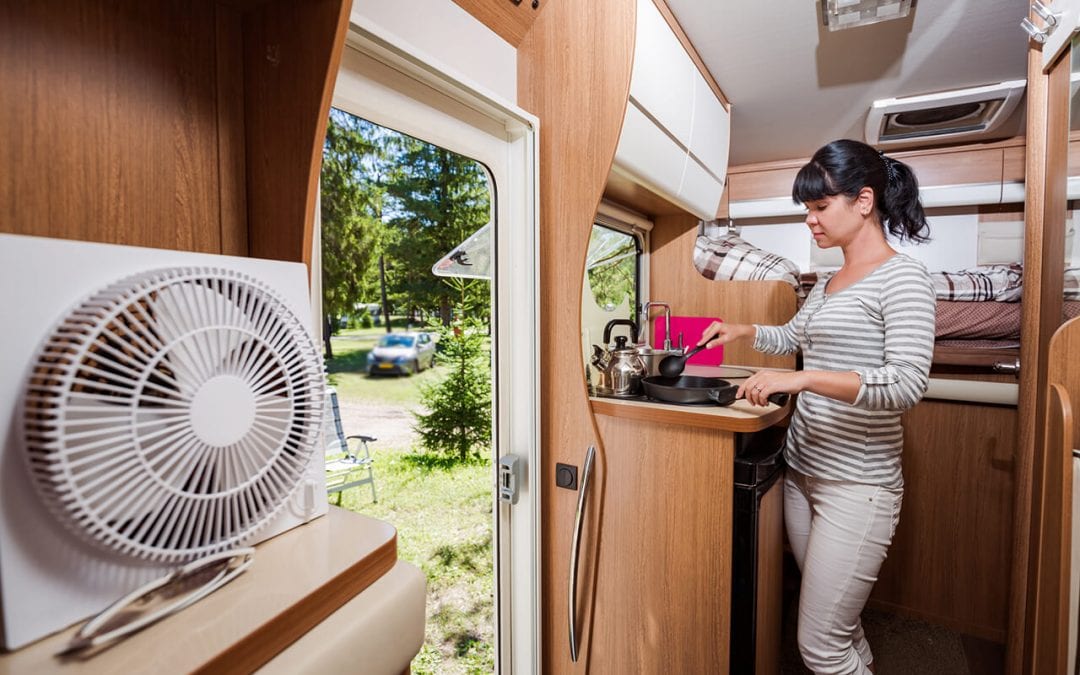Excess moisture can cause damage to your RV or travel trailer. It has the potential to rot wood, rust metal, and promote mold growth. Unless you reside in a desert area, you’ll probably need to take multiple steps to minimize indoor humidity levels. Read on for our RV moisture control tips that you can use to protect your travel trailer.
1. RV Moisture Control When Showering
Open a vent and shut the door to the bathroom when you shower. If you have an exhaust fan, always switch it on while you bathe and let it run for several minutes afterward.
2. Dry the Walls After Showering
When you finish showering, use a squeegee to remove water drops from the inside surface of the shower stall. Your goal is to move the water from the walls and into the drain so it doesn’t evaporate into the air. Wipe it down with a towel to get the walls completely dry. If allowed to evaporate, it would be putting as much as a cup or more of water into the air after each shower session and possibly affect surfaces inside your trailer, such as blankets, walls, drapes, and carpets.
3. When Preparing Meals
When you cook food or boil water in a motorhome, put lids on the pots. An outside vented exhaust hood or powered vent fan can help with RV moisture control. If you own a barbecue grill, try to prepare hot meals outdoors whenever possible.
4. Use a Sensor
Using a relative humidity (RH) sensor or hygrometer to measure the amount of moisture in a travel trailer will help you respond accordingly to humidity levels. The optimal relative humidity level is 40%, but any percentage below 60% will significantly decrease the risk of mold and mildew. Many digital temp sensor units offer a relative humidity display. We recommend a device with a wireless outdoor sensor and indoor display for both temperature and humidity.
5. Drying Clothes
Do not dry clothing inside the RV whenever possible. Drying releases considerable quantities of moisture vapor into the air. You can avoid moisture problems by using an outdoor drying rack, setting up a clothesline, or visiting the nearest laundromat. Keep in mind that non-vented dryers release the moisture into the air within the camper. For optimal RV moisture control, only use a vented dryer or dry clothes away from the RV.
6. Increase Ventilation
Open windows and vents when weather permits. Even if you only raise a window one inch, this will help release humidity from the camper and allow fresh, drier air to replace it. Try to increase ventilation when several people gather inside an RV. Use fans to move the air around and dry up excess moisture.
7. Wipe Down Excess Moisture When You See It
Regularly check your kitchen counter for water spills and windows for condensation. When water droplets appear on any indoor surface, wipe them up as soon as possible. Remember to dry the towel outdoors unless it’s raining.
8. Use Your AC for RV Moisture Control
If you have an A/C system, always use it during hot, humid weather. Air conditioning equipment doesn’t only cool your recreational vehicle; it also decreases the amount of moisture in the air. Another easy, effective way to control the humidity level is to use a dehumidifier. Since it won’t affect the temperature, so you can run it in any weather.
RV Onsite Services provides Raleigh, NC and the surrounding areas with RV inspection and repair services. Contact us to book our services.

